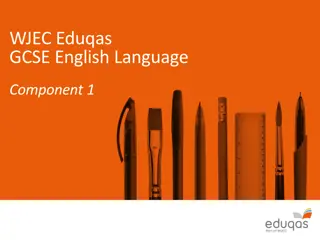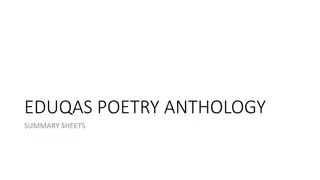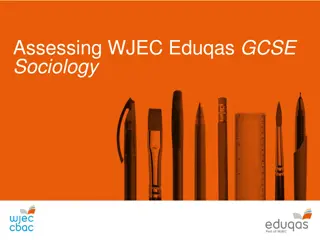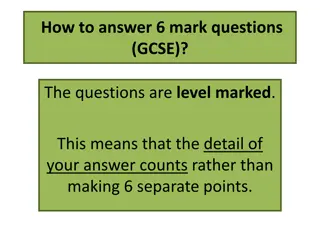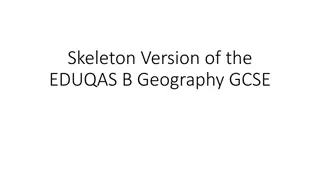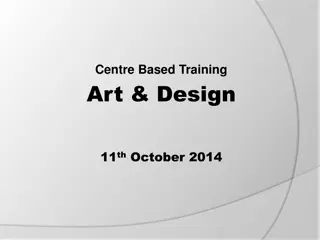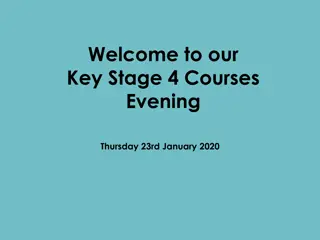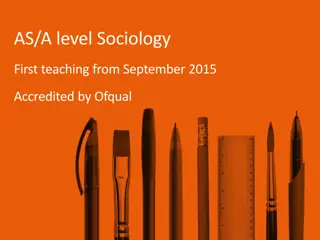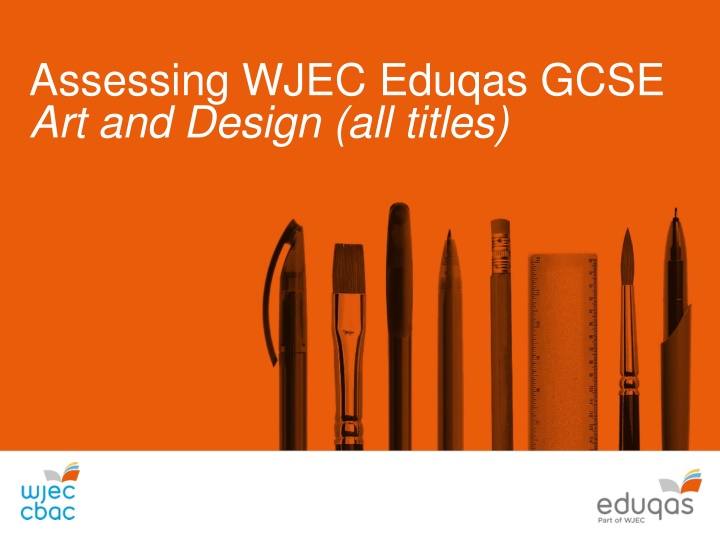
Approaching Assessment for WJEC Eduqas GCSE Art and Design
Ensure consistent, unbiased, and standardized assessment practices for GCSE Art and Design. Utilize evidence-based portfolios and authentication to maintain integrity. Understand and apply the assessment criteria for accurate evaluations. Document assessments effectively to support students' progression.
Download Presentation

Please find below an Image/Link to download the presentation.
The content on the website is provided AS IS for your information and personal use only. It may not be sold, licensed, or shared on other websites without obtaining consent from the author. If you encounter any issues during the download, it is possible that the publisher has removed the file from their server.
You are allowed to download the files provided on this website for personal or commercial use, subject to the condition that they are used lawfully. All files are the property of their respective owners.
The content on the website is provided AS IS for your information and personal use only. It may not be sold, licensed, or shared on other websites without obtaining consent from the author.
E N D
Presentation Transcript
Assessing WJEC Eduqas GCSE Art and Design (all titles)
Approaching assessment It is expected that all teachers will use a consistent evidence base, such as each student s portfolio, to support consistent judgements. Regardless of which approach to assessment you take, you should ensure that it is: the same for every student in the cohort (as far as possible) standardised across teaching groups and different titles free from bias and discrimination. You are advised to refer to the WJEC Eduqas assessment materials and exemplars available on the secure website and WJEC Eduqas Art and Design webpages to establish standards by which to assess the work of your students, as these examples have been selected by a team of senior examiners/moderators and are quality assured. The Assessment Videos, available on Lightbox, make reference to the relevant mark schemes to support your marking and will help to give you confidence when making and explaining your judgement about a student s level of attainment evident in their portfolio.
Authentication of evidence General assessment advice - Authentication It is important that any work by students that is not completed under supervision, such as at home, should be verified as being their own, unaided work. This is of utmost importance in order to protect the integrity of submissions, as well as verify your judgement of standards. It is recommended that use is made of the usual My Creative Statement and Authentication Document.
Authentication of evidence General assessment advice Authentication (continued) Teachers should complete the usual authentication statement, declaring that all reasonable steps have been taken to validate each submission. All secondary source materials, such as images of artists or photographers' works or quotations, must be clearly acknowledged. Any work which is not entirely that of the student should be identified either within the body of the work or in the Authentication Document.
Assessment criteria Understanding the assessment criteria Assessing work for GCSE Art and Design involves the exercising of professional judgement based on a thorough understanding and application of the four Assessment Objectives. To make accurate assessments, renewed understanding of the assessment criteria is essential. It is recommended that you quickly read through the following documents to remind you of what these are: AO Checklist GCSE Guidance for Teaching pages 10 to 22 Indicative Content for each of the 7 titles GCSE revision resources for Art and Design - Knowledge Organisers
Documenting assessment Before starting your marking, it is suggested that you view at least one of the Assessment Videos relating to the title/s that you will be assessing.These can be accessed on the Lightbox website. While you are viewing these, take note of the in which documents, such as AO checklists, Indicative Content and Mark Scheme are used to secure professional judgements. You could use an individual GCSE Art and Design Candidate Mark sheet to record the judgements that are made by the assessor, with references to the documents listed in the previous slide. The same approach could be used to record your judgements when assessing work for Summer 2022.
Applying assessment criteria Benchmarks Following your viewing of appropriate Assessment Videos, you are advised to select several marked exemplar from Lightbox and the WJEC Eduqas Art and Design website and use these to make comparative judgements with work that you will initially mark for Summer 2022 assessments. These will act as benchmarks of your own students' work that you can continually refer to as you proceed with your marking.
Process of assessment Standardisation The benchmarks, together with online marked exemplars, can be referred to throughout the process of your marking to maintain the reliability of ongoing assessments, as well as for possible standardisation purposes. Teacher assessments will need to conform to arrangements made within centres to ensure standardisation within and between subject areas. It is suggested that other departmental/faculty staff, as well as the students teacher/s, might be involved in determining benchmarks, following a similar process to that suggested in the previous slide.
Process of assessment Standardisation (continued) Those involved in making these benchmark assessments should first mark independently and record their judgements. These can then form the basis for discussion and negotiation to arrive at a collectively agreed mark for each benchmark. Ensure that everyone's judgement is valued. At this point, comparisons can be made with benchmarks in other titles, across other subject areas within a faculty and, if required, with other centres.
Process of assessment Applying the assessment criteria at present In present circumstances, it will be necessary to relax normal expectations of coursework evidence, particularly regarding breadth of experiences, processes and outcomes. To compensate for this, students might have engaged in greater depth with one or more of these and this can be duly rewarded through the four assessment objectives. Where outcomes are not strongly evident, more account may be taken of the quality of the creative processes by which these might have been achieved- such as in maths where there is no final answer, but the workings out show understanding of, and engagement with, the problem.
Process of assessment Applying the assessment criteria at present (continued) It is possible that certain students might have deviated from the main subject of their enquiry as it progressed, such as by responding to online learning resources or switching to more accessible subject matter in their home or local environment. This evidence could be taken into account, providing it relates to one or more of the Assessment Objectives. All students should be required to complete the My Creative Statement so that, for the purpose of assessment, the creative path with reasons for possible diversions, can be readily followed.
Process of assessment It is important to ensure objectivity in assessing students responses, both at the initial marking stage and during internal standardisation. Do not allow personal knowledge of individual students to affect assessment decisions: ensure that you mark the student responses in front of you rather than the students behind them. You should also consider the purpose of the assessment, particularly if you are selecting evidence which has been completed earlier in the course. Formative assessment, conducted during the course of the learning, may not always provide appropriate evidence. Summative assessment, at the end of the course, is more likely to provide a realistic picture of the students attainment levels.
Process of assessment Applying the assessment criteria at present (continued) Incomplete work may be presented for assessment and some students may not have brought their Portfolio to a fully resolved conclusion. Within their portfolios, alternative materials, more accessible processes and viable formats should be acceptable, such as through the use of PowerPoint to show possible layouts, different colourways and how proposed large-scale work might look in location. If access to specialist equipment or size and cost of a preferred format is a constraint, then this could be drawn, described and/or presented as a scale model constructed from paper or card. Further information relating to these issues is available online in the JCQ Notice to Centres document.
Process of assessment Teachers should, wherever possible, use the band descriptors in the mark scheme provided for the component as a starting point for assessing student's work. Assessment Videos that are available on the Lightbox website provide examples of this procedure. Indicative Content for each title in the GCSE Art and Design Specification can be used as a guide to the types of skills and knowledge expected for meeting the requirements of this component.
Process of assessment Applying the assessment criteria The appropriate band for each assessment objective should be established by determining which performance descriptor best reflects the student's performance. The appropriate mark should then be established by determining the extent to which the student's work has met the criteria within the relevant band. It should be noted that the bands have been designed to assist the marking process by identifying individual levels of achievement and they do not necessarily correlate with grade boundaries.
Process of assessment Applying the assessment criteria First - identify the appropriate band a student s response falls into according to the criteria. Award a band where the student s response covers the majority of the criteria. Second - award a mark in the centre of the band and then increase or decrease the mark depending on the quality of the response, which may be reflected in the amount of indicative content covered.
Process of assessment Applying the assessment criteria If a response falls between two bands, consider whether there are more characteristics of the higher or lower of the two bands and award accordingly. The total marks for all four assessment objectives may reflect performance at different bands across the assessment objectives, for example, a candidate may achieve band 4 for AO1 and band 5 for AO2.
Process of assessment Applying the assessment criteria Recognise that teachers experience and existing knowledge of assessment criteria and of standards are not sufficient in themselves to accuracy. It is essential to also refer to WJEC Eduqas marked examples available online. Beware of inflation of marking around perceived grade boundaries and the bunching of marks just above this boundary. The top 10 percent of marks should be reserved for only truly exceptional work. The award of unrealistically high marks can indicate low expectations and a lack of awareness of what exceptionally able candidates are capable of achieving.
Process of assessment Recording assessment decisions Finally, consider how you might produce a record of each assessment to justify the judgements you have made. It is advisable to produce this as you mark each portfolio. The individual Candidate Marksheet may be used for this purpose but take account of how long this could take and how you might make best use of your time. Consider copy and paste methods, underlining and adding to relevant phrases from mark schemes or other sources, such as Indicative Content, to make efficient use of your time. The recording of assessment decisions will need to conform to arrangements made within Centres to ensure a consistent approach.
Any Questions? If you have any questions, contact our specialist subject officers and administrative support team for your subject with any queries. artanddesign@eduqas.co.uk


